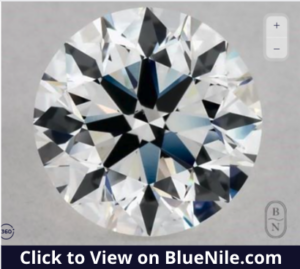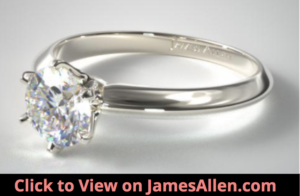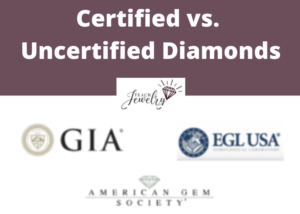
One of the most important decisions during the process of buying a diamond is whether to choose a certified or uncertified diamond.
No matter if you’re buying online, secondhand, or from a retail store, you’ll likely come across both options, or even a third one called self-certified.
Diamonds are often a significant financial purchase, and making the right decision about a certified versus uncertified diamond can make or break that investment.
You’ll either have the confidence you own a quality gem or potentially overpay for a diamond that lacks the characteristics you thought it had.
In this article, we’ll explore:
- What it means if a diamond is certified or uncertified
- Which organizations certify diamonds (and what to know about them)
- What’s included on a diamond certification
- Benefits of certification
- If you should ever buy an uncertified diamond
Being informed in these areas will help you purchase the right diamond.
What is a Certified Diamond?
Certified diamonds have had their characteristics evaluated by an independent grading lab in order to verify its quality.
These third-party organizations consist of expert gemologists who assign the diamonds grades across key traits. This give the buyer confidence they aren’t paying for a diamond that isn’t as high quality as they thought.
The findings are presented in a grading report that details the elements of the diamond. The report is marked with a serial number, and that serial number is often engraved on the diamond in a way that can only be seen through a microscope.
The certification itself doesn’t automatically make a diamond more valuable. It’s the grades the diamond is given that determines its value.
What is an Uncertified Diamond?
Uncertified diamonds haven’t been graded by an independent, third-party gemologist across the key characteristics that determine the quality of a diamond. This means the average consumer cannot verify its quality, so they can’t accurately estimate its monetary value.
It’s estimated that close to 75% of diamonds on the market aren’t certified.
Why would a jeweler not certify a diamond?
One reason is because it costs money to do so. They may decide it’s not worth the several hundred dollars it could cost because it wouldn’t increase the sale price enough to cover the difference.
This is the case for low-quality diamonds that won’t sell for a high price anyway, or a very small diamond where the exact grades won’t matter as much to the buyer.
Another reason is because it slows down the sales process because certifying a diamond can take several weeks.
An uncertified diamond isn’t necessarily a lower quality diamond than a certified one.
The difference is the uncertified diamond hasn’t had it’s quality verified by a gemologist not involved in the sale, so the buyer can’t have as much confidence in its value.
Which Organizations Certify Diamonds?
The value of a diamond certification is dependent on the quality of the evaluating organization. There are many third-party certifiers, but three of the most popular are:
- Gemological Institute of America (GIA)
- Europeans Gemological Laboratory (EGL)
- American Gem Society (AGS)
Let’s examine each of these organizations in more detail and learn whether their grading reports are considered reliable.
GIA
The GIA is considered the gold-standard for certifying diamonds. It’s the most respected because they provide consistent grades across the many elements of a diamond, namely the four Cs they’re credited for developing — color, clarity, cut, and carat.
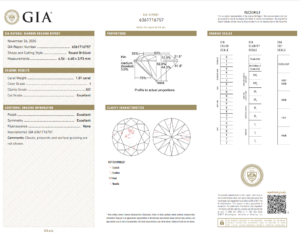
The first two are most important to have a reliable measure for because they’re the most subjective.
Cut is easier to give an objective measurement on, and carat is a unit of weight, so there’s no mistaking it.
Color and clarity are graded on a scale, where the naked eye has a difficult time telling the difference between one, two, or even three grades.
The most reputable jewelers will display the GIA report on their diamonds, especially online retailers such as Blue Nile, James Allen, and Brian Gavin.
When shopping for any of their diamonds, you can either see the GIA report immediately or request it be sent.
If you’re purchasing a diamond, a GIA report gives you complete confidence in the grades it’s assigned.
EGL
The EGL has offices around the world in places such as Europe, Canada, New York, and Miami. It’s an independent network of gemological laboratories that offers similar certification services as the GIA.
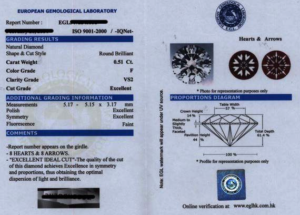
Though their services are similar, the EGL is not considered as reliable or authoritative in their reports.
As a general rule, the EGL is known to grade diamonds one or two levels higher than the grade it would receive from the GIA.
While this difference might not seem like a big deal, if this is applied across color, cut, or clarity, it paints an entirely different picture of the diamond’s quality.
For example, if the GIA were to grade a diamond as a G color (the highest level of “near colorless”), the EGL might give it an E or F (colorless).
If the jeweler used the EGL report, the buyer would pay a premium because it’s a colorless diamond.
Paying based on an EGL report as opposed to a GIA report could result in overpaying by thousands of dollars, so many experts advise not purchasing an EGL-certified diamond.
AGS
If the GIA is the top organization for certifying diamonds, and the EGL is one many buyers are skeptical of, where does that leave the AGS?
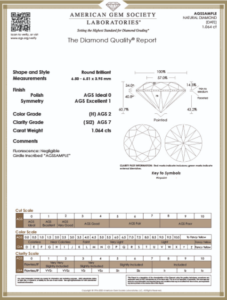
Most experts place the AGS more in line with the GIA and consider it a reliable organization to certify the quality of diamonds.
They were founded in 1934 to protect the general public from fraud and false advertising, and that’s the purpose they still serve today by providing consistent grading reports.
In fact, their expertise is in grading the cut of a diamond, which is considered the most important aspect of its quality.
It’s less common for jewelers to display an AGS report because the GIA is more widely known, but you can be confident in the results of a GIA certification.
What’s Included on a Diamond Certification?
It’s important to know what’s included on a diamond certification because these aspects of a diamond determine its monetary value. Each organization’s report varies slightly but generally cover elements such as:
- Serial number
- Cut
- Color
- Clarity
- Carat weight
- Symmetry
- Fluorescence
- Culet size
- Comments
You’ll also see a diagram that points out the types and positions of inclusions, which are imperfections in a diamond. Use the key to learn the meaning of each symbol.
For example, the GIA report for this one-carat round cut diamond indicates it has crystals, feathers, clouds, needles, indented naturals, and naturals.
There are more crystals than other types of inclusions, though needles and naturals are obvious from the pavilion view.
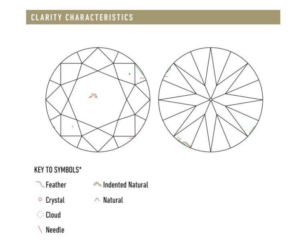
You should also read the comments section of the certification.
This is where the gemologist provides detail on the grades or makes notes about its quality not shown elsewhere on the report.
Another aspect that’s critical to consider is whether the diamond has been clarity enhanced.
Clarity-enhanced diamonds have had their inclusions fixed by methods such as laser-drilling or fracture-filling.
Some organizations won’t certify clarity-enhanced diamonds, but if it’s noted on the report, it’s important not to overlook it. It won’t sell for as high of a price and its resale value is diminished.
What are the Benefits of a Certified Diamond?
There are significant benefits of a certified diamond versus an uncertified one.
These benefits are why it’s recommended to buy a certified diamond in almost every situation, especially if you’re spending thousands of dollars on it.
The primary benefit of certification is it gives you confidence in the price.
The price of diamonds vary depending on its quality, and those qualities are what certifiers are examining. If you bought a diamond thinking it had an “excellent” cut, but the cut was actually “good,” you will have overpaid for the diamond.
The same is true for nearly every other characteristic — color, clarity, carat, symmetry, polish, and more.
The average consumer shouldn’t trust their naked eye to determine the quality of a diamond, and a certificate solves this problem.
The second benefit is for jewelry insurance. It’s often wise to buy insurance on high-value diamonds, but it’s difficult to prove its value to the insurance company without a report. In most cases, having a GIA, AGS, HRD, or IGI diamond report is sufficient for an insurance company to properly appraise the diamond.
The third benefit involves a resale. If you ever plan to resell the diamond, a certification gives confidence to the buyer of its quality.
In the same way you wanted assurance when you initially bought the diamond, and were willing to pay more for it, the new buyer will likely want the same.
Should You Ever Buy an Uncertified Diamond?
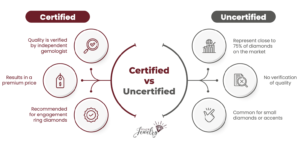
There are some instances in which it’s okay to buy an uncertified diamond. For example, if you only plan to spend a few hundred dollars on a small diamond, it may be hard to find one in that category that’s certified.
For the jeweler, it wouldn’t be worth the time and expense to send it to the GIA, EGL, AGS, or others such as GCAL to have it graded.
In a similar way, diamond accents don’t generally come with individual certifications. The diamonds are so small it would be difficult for the naked eye to tell the difference in color, cut, or clarity, so buyers don’t require the same assurance.
You might also come across a diamond promoted as self-certified. That likely means the jeweler selling you the diamond has examined and graded it themselves.
There’s an obvious conflict of interest, because the jeweler has incentive to grade it a higher quality than it actually is, so they can sell it for a higher price.
It’s worth exploring the grades given in a self-certified diamond, but don’t rely on that certification to make your buying decision. Instead, treat it similar as you would an uncertified diamond.
Conclusion
If you’re purchasing an expensive diamond, there’s no doubt you’ll come across instances of certified versus uncertified diamonds.
The industry is fraught with sellers trying to maximize the selling price of a diamond, and a certification is a way to protect the consumer from overpaying.
Unless you’re buying a small diamond or accent, or one you know is of a lower quality, always request the certification and ensure it matches the diamond you plan to buy.
The certification doesn’t mean it’s a high-quality diamond — it could be certified with low scores across the primary traits — but at least you’ll know its value.
Use your judgement and never pay a high price for an uncertified or self-certified diamond.
You could easily be deceived into thinking it’s worth more than it is, and it’ll be difficult to go back on that purchasing decision.

Jacob Clarke
Jacob Clarke is the founder of TeachJewelry.com.
He earned an Applied Jewelry Professional Diploma from the Gemological Institute of America (GIA) and now brings you essential information about diamonds, settings, and more.
Jacob has consulted with leading jewelry brands, and his work has been cited in Clean Origin, Diamond Nexus and industry publications.
He's also a member of the International Gem Society.
He enjoys discussing jewelry with readers, so contact him with any questions at jacob.clarke@teachjewelry.com.

